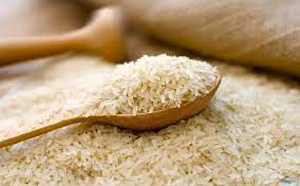 Local production still wobbles around 30%
Local production still wobbles around 30%
Ghana’s rice import, in the last decade, according to the Ministry of Food and Agriculture (MoFA), has hit a staggering US$8 billion.
Though domestic production has been appreciably increasing, currently estimated at 30 per cent, local consumption demands constantly exceed domestic production, giving the impetus for the constant rise in imports annually.
Ghana imports almost 70 per cent of its rice mainly from Thailand, Vietnam, India, and the USA, with an annual estimated import averaging more than US$550 million. With a current deficit of 656,000 metric tonnes, the government is relying on recently adopted strategies to increase production, with an anticipated surplus of 365,302 metric tonnes by 2023.
Rice has become the second staple food consumed in Ghana after maize, with production increasing from 48,800 tonnes in 1970 to 925,000 tonnes in 2019, growing at an average annual rate of 9.03 per cent, according to MoFA.
Though the figures depict high potential for growth in local production, challenges including access to finance, labour, inadequate combine harvesters, land acquisition systems, and bush fires continuously threaten the crop’s production.
For instance, in the Builsa South District, an average of 370 acres of rice farms are destroyed by bushfires annually. This situation has led to the loss of over GH¢1 million in revenue each year, with smallholder farmers being the hardest hit. That district is estimated to lose over GH¢5 million in revenue by 2025 if the trend continues without any interventions.
Being one of the first countries in the sub-region to launch the National Rice Development Strategy, Ghana has already missed out on its local rice production agenda as part of the Coalition for African Rice Development policy.
That strategy, unveiled in May 2008 as the National Rice Development Strategy for 2009-2018, aimed to increase domestic production up to 70 per cent and promote consumption through quality improvement, targeting both the local and international markets.
The strategy ended almost three years ago, achieving an opposite target of rather a 70 per cent import with the consuming Ghanaian public still largely dependent on imported rice brands.
Current government strategies on rice production
Apart from the Planting for Food and Jobs (PFJ) which has introduced some interventions into the cereal’s production through subsidized fertilizer and increased area of cultivation, from 44,000 hectares in 2017 to 175,000 hectares in 2020, the government has recently introduced fresh policies and production targets to reduce imports.
Current rice sector interventions to increase production include an inclusive rice value chain development strategy, which is ending this year, 2021. It aims to improve the livelihoods of 128,764 smallholder farmers to increase cultivation capacity.
There is also the rice value chain improvement strategy being financed by the Korean government in the Central Region, valued at US$9 million. It targets 5,000 direct beneficiaries and 15,000 indirect beneficiaries. This program which started in 2019, is expected to end in 2023, creating an impact for farmers in Assin Fosu, Assin South, North, Twifo Atti Morkwa, and Gomoa East areas.
Others include the Special Rice Initiative (SRI), Ghana Commercial Agricultural Project, Savannah Zone Agricultural Productivity Improvement Project, and several other policies to increase domestic production.
- UNICEF supports Ghanaian startups to accelerate SDGs achievement
- WAFU-B U-20 Championship: Black Satellites train ahead of Burkina Faso must-win game
- Upper East to become hub for rice and livestock production – MOFA
- Today in 2010: Farmers call on government to ban importation of rice
- E-commerce firm Shopnaw launched
- Read all related articles
